404 Error: Page cannot be found
Page : https://www.cds.kent.sch.uk/439/dance
The page you were looking for cannot be found. It may have moved or been deleted.

19/12/25
Wishing all our CDS pupils and their families a very Happy Christmas! We hope you enjoy a restful and joyful holiday, and we look forward to welcoming everyone back on 5 January. Wishing you a Happy and Prosperous New Year!
follow us @tcdskent

18/12/25
Our school community came together for a Reverse Advent Challenge, with tutor groups collecting food donations for Thanet Food Link. We’re proud of the kindness and teamwork shown by pupils, staff, and families. Thank you for helping us spread hope and joy this festive season!
follow us @tcdskent

18/12/25
Our talented Year 9 Hospitality pupils have been busy baking and decorating the most incredible Christmas cakes, and the results are absolutely stunning! From festive designs to creative details, each cake is a masterpiece that truly captures the Christmas spirit.
follow us @tcdskent

17/12/25
We had an amazing two days this week, completing the first 2 Cultural Capital days of the year! Our pupils embraced a wide range of activities designed to broaden horizons and encourage new experiences. #cdsculturalcapital
follow us @tcdskent

17/12/25
We're proud to announce that we’ve been awarded the National Award for Online Safety 2025-2026! This incredible achievement highlights our commitment to helping pupils navigate an ever-changing online world safely and confidently. Together, we’re building a safer digital future!
follow us @tcdskent

02/12/25
Y8 pupils have been getting into the Christmas spirit by creating adorable reindeer-themed burgers! They made smash burgers from scratch, Shaping the patties, pan-frying them to perfection, and then adding all the festive garnishes to turn them into these seasonal treats.
follow us @tcdskent

28/11/25
Our amazing CDS Engineering Club pupils have been busy soldering tiny connections, to bring their festive creations to life – flashing Christmas trees! This project isn’t just about Christmas cheer – it’s about learning real-world skills like accuracy, patience, and teamwork.
follow us @tcdskent

20/11/25
Our Life Skills Cooking Club is getting into the holiday spirit! Pupils rolled up their sleeves this week to make delicious cookie dough, and had a blast decorating with colourful sprinkles. Nothing says festive like sweet treats and creativity! #cdsfood #cdshospitality
follow us @tcdskent

18/11/25
Thanks to your incredible support we’ve raised £1,537 for Children in Need! Thank you to everyone who contributed – you’re amazing! Let’s keep spreading kindness and making positive change. #cdsChildrenInNeed #cdsThankYou #cdsCharity
follow us @tcdskent

14/11/25
Every child’s learning journey is unique, and as parents, your support can make all the difference! Attached are some practical ways to help your child thrive.
follow us @tcdskent

13/11/25
For Life Skills Cooking Club this week we were very lucky to have a special guest, none other than master baker Stephen Gadd from @Staplestores. We would like to thank Steve so much for the wonderful new experience and exciting opportunity he provided for our pupils! #cdsfood
follow us @tcdskent

11/11/25
Year 10 Graphics pupils were asked to design a brand and logo for a company. They created mock-ups of their designs so that we could see them in context. We think you’ll agree, there are some great designs here - Well done Year 10! #cdsgraphics
follow us @tcdskent

11/11/25
Ever feel like your voice isn’t heard as a young person? Vote in the KYCC elections! The countdown to this year’s Kent Youth County Council elections has begun and it is time to vote! kent.gov.uk/about-the-counci… We are lucky enough to have Tommy standing for election for KYCC!
follow us @tcdskent

10/11/25
Our head pupils proudly took part in the Broadstairs Remembrance Service, joining the community in honouring those who served and sacrificed for our country. We are incredibly proud of their participation and the values they continue to uphold. Lest we forget.
follow us @tcdskent

05/11/25
Due to Year 11 mock examinations, and no indoor space available, Sports Clubs will be cancelled until week commencing the 17 November. However, the PE department will be running the Wednesday Clubs which are Netball and Fitness. Apologies for any inconvenience.
follow us @tcdskent

05/11/25
Welcome back to Life Skills Cooking Club! This week we enjoyed making cheese scones, a traditional and delicious British snack, or a lovely additional to an afternoon tea. But the question is, how do you pronounce scones?
follow us @tcdskent

05/11/25
Thinking of your Sixth Form place, have you considered Barton Court Grammar School? Find out more: https://t.co/FyhqjdOcWb We also have an Open Evening on Wednesday 21 January 2026 6.30 – 8.30pm. Put a reminder in your calendar and we look forward to meeting you. pic.twitter.com/CE7B3zYXwR
follow us @tcdskent

04/11/25
We will be proudly selling poppies to staff and pupils to honour, and remember, those who have served and sacrificed. Prefects will be selling poppies in the Heart during break/lunch times leading up to the 11 November. Let’s wear our poppies with pride and show our support!
follow us @tcdskent

04/11/25
We’re proud to announce our donation of £3,239.03 to The Hygiene Bank, Thanet, a charity working tirelessly to ensure everyone has access to the basic hygiene products they need to live with dignity. A big thank you to them for the donations they provided for our CARE boxes.
follow us @tcdskent

30/10/25
follow us @tcdskent
The page you were looking for cannot be found. It may have moved or been deleted.